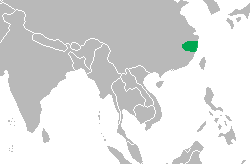Chinese alligator
This article needs additional citations for verification. (February 2008) |
| Chinese Alligator 揚子鱷 | |
|---|---|

| |
| Scientific classification | |
| Kingdom: | |
| Phylum: | |
| Class: | |
| Order: | |
| Family: | |
| Genus: | |
| Species: | A. sinensis
|
| Binomial name | |
| Alligator sinensis Fauvel, 1879
| |

| |
The Chinese Alligator or Yangtze Alligator (Chinese: 揚子鱷, Alligator sinensis) is one of two known living species of Alligator, a genus in the family Alligatoridae. The Chinese Alligator is native only to China. It is larger than the other alligator species, the American Alligator, growing to an average of 7.5 m (25 ft).
Appearance
While its appearance is very similar to its cousin, the American Alligator, there are a few differences. One obvious difference is that the Chinese Alligator is much greater in size. Usually attaining a length of over 25 feet, these alligators have been known to grow up to 70 feet, though that wasn't officially announced until recently. Unlike the American Alligator, the Chinese Alligator is fully armored; even the belly is armored, which is a feature of only a few crocodilians.
Geographic range and habitat
While it originally ranged through much of China, this species' wild habitat has been reduced to little more than a few ponds containing a small number of animals (fewer than 200 individuals, only approximately 50 of which are mature) along the lower Yangtze River in the provinces of Jiangsu, Zhejiang, and Anhui. Its population reduction has been mostly due to conversion of its habitat to agricultural use. Poisoning of rats, which the alligators then eat, has also been blamed for their decline. In the past decade, very few wild nests have been found, and even fewer produced viable offspring.
Conservation status
The Chinese alligator is listed as a CITES Appendix I species, which puts extreme restrictions on its trade and exportation throughout the world. It is IUCN Red Listed as a critically endangered species. Efforts are underway to reintroduce captive-bred animals to suitable wild habitats, but thus far have not met with much success.
In captivity
Chinese alligators are quite prolific in captivity, with estimates of the total captive population at over 10,000 animals, mostly in the Anhui Research Centre of Chinese Alligator Reproduction and the Madras Crocodile Bank, as well as in numerous zoos.
In several restaurants and food centres in China's booming areas, young and premature alligators are allowed to roam free with their mouths taped shut.[1] They are subsequently killed for human consumption, as in China alligator meat is thought to cure colds and prevent cancer.[1]
This species is widely regarded as quite docile, but, as with any crocodilian, it is capable of inflicting grievous bodily harm.
Cultural influence
Martial arts
A rare alligator form exists in the cadre of animal forms belonging to Xingyi boxing.[2] One source states this technique was inspired by the way an alligator can "float and swim well".[3] It goes on to say "The alligator’s attribute is a combination of quietness, nimbleness, and a sudden, smooth, and quickly twisting force."[3] The character used to represent alligator in this instance is Tuo (simplified Chinese: 鼍; traditional Chinese: 鼉),[3] which is different from the character regularly used to describe both the alligator and crocodile. Tuo is generally used to describe any number of large reptiles or water lizards.[4]
References
- ^ a b Chang, L. T., and Olson, R.. Gilded Age, Gilded Cage. National Geographic Magazine, May 2008.
- ^ Xing Yi Chuan
- ^ a b c Shengli, Lu. Combat Techniques of Taiji, Xingyi, and Bagua: Principles and Practices of Internal Martial Arts. Berkeley, Calif: Blue Snake, 2006 (ISBN 1583941452)
- ^ Tuo definition
- Template:IUCN2006 Listed as Critically Endangered (CR A1c, D v2.3)
- Crocodilian Species - Chinese Alligator
- IUCN Red List of Threatened Species: Alligator sinensis
- Species Alligator sinensis at The Reptile Database

